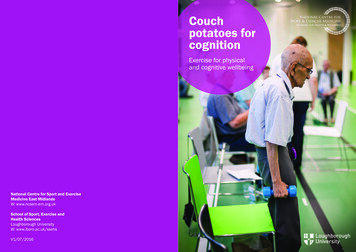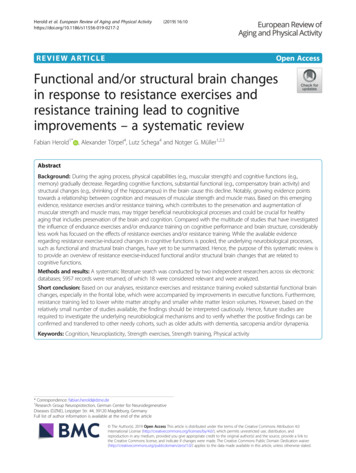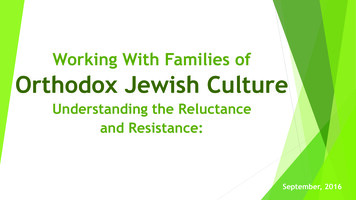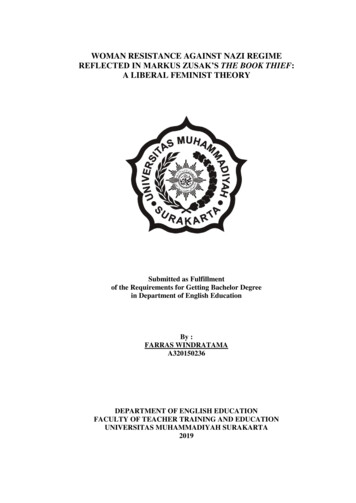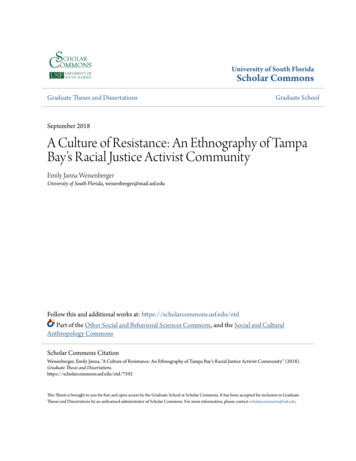
Transcription
University of South FloridaScholar CommonsGraduate Theses and DissertationsGraduate SchoolSeptember 2018A Culture of Resistance: An Ethnography of TampaBay’s Racial Justice Activist CommunityEmily Janna WeisenbergerUniversity of South Florida, weisenberger@mail.usf.eduFollow this and additional works at: https://scholarcommons.usf.edu/etdPart of the Other Social and Behavioral Sciences Commons, and the Social and CulturalAnthropology CommonsScholar Commons CitationWeisenberger, Emily Janna, "A Culture of Resistance: An Ethnography of Tampa Bay’s Racial Justice Activist Community" (2018).Graduate Theses and 592This Thesis is brought to you for free and open access by the Graduate School at Scholar Commons. It has been accepted for inclusion in GraduateTheses and Dissertations by an authorized administrator of Scholar Commons. For more information, please contact scholarcommons@usf.edu.
A Culture of Resistance:An Ethnography of Tampa Bay’s Racial Justice Activist CommunitybyEmily Janna WeisenbergerA thesis submitted in partial fulfillmentof the requirements for the degree ofMaster of Arts in Applied AnthropologyDepartment of Anthropologywith a concentration in cultural anthropologyCollege of Arts and SciencesUniversity of South FloridaMajor Professor: Antoinette Jackson, Ph.D.Cheryl Rodriguez, Ph.D.Daniel Lende, Ph.D.Date of Approval:August 27, 2018Keywords: intersectionality, capitalism, police brutality, criminal justice, public policy,discriminationCopyright 2018 Emily Janna Weisenberger
Table of ContentsAbstract iiIntroduction . .1The Researcher’s Entry into the Community . .5Purpose and Goals 7Conceptualizing Critical Race Theory and Black Feminist Thought . .9Deep Hanging Out: Methods and Structure in the Activist Community . .18Deep Hanging Out . 21Motivations . . 28Racism as a Real Threat in the Literature . 29Racism as a Real Threat in Tampa Bay . 34Motivating Experiences with Racism 36Motivations to Avoid Activism . . 42Anti-Racist Ideology . . . 47“Capitalism Sucks”: Anti-Capitalist Ideology . . .48Anti-Capitalist Ideology in Practice . . 50Practicing Intersectionality in the Activist Community .58Space, Voice, and Identity . . . . 61Confronting Inequality within the Community . 64Critique . . . 65Acts of Resistance. 69Covert Activism . . 70Overt Activism . . 75Acting out Activism through Group Dynamics . 79Conclusion . . .83Limitations and Future Research . . .86Recommendations .87References . . .91Appendix A: Sample Interview Guide . .99Appendix B: Demographic Breakdown of Interviewees . .101i
Appendix C: May 28, 1996 Newspaper Clipping from the Palm Beach Post .103Appendix D: Institutional Review Board Approval Form .104ii
AbstractRacial justice activists in Tampa Bay comprise a community and culture structured as amovement of social transformation. Data from eleven interviews and more than 100 hours ofparticipant observation show that activists consist of a diverse array of Tampa Bay residents ofvarying ages, genders, sexualities, racial/ethnic identities and livelihoods. This community isbest described by their beliefs and practices of ideology steeped in intersectionality and anticapitalism, and are motivated by or empathetic to racial injustices directly experienced by themor those around them. The intention of this paper is to describe activists as they are rather than asthey are depicted in the popular imagination, as well as to share the insights of racial justiceactivists to the public for their own use in resisting injustices.iii
IntroductionWhat an odd picture we must have been to the drivers speeding by us on the highway.Some honked as us, disrupting the subdued mood with loud horns. Well past sundown on a coolFriday in November, thirty one people stood in a circle, surrounding a homemade plywood sign– a memorial for a local boy. Our heads bowed, we listened quietly as a Black woman intoned aprayer in the name of Jesus to, among other hopes, end White supremacy. A three-year-old girltwirling a white rose disrupted the silence periodically. Her mother intervened, shushing her. Onmy left, my hand was clasped with that of a White man I had met just that night, and on my rightwith a Black woman I had been “organizing” with for months. Red and white roses were tuckedinto our pockets, to be placed at the foot of the sign.The Restorative Justice Coalition’s co-founder, a White man, organized the evening withthe family of Andrew Joseph III after the grieving couple had approached him. Having lost theirBlack fourteen-year-old son to what they see as racially motivated police misconduct almost fouryears previously, they need activists to rely on and wanted help to share in the burden ofadvocating, educating, and lobbying, particularly during their multi-year lawsuit against theHillsborough County Sheriff’s Office. This night was a community event memorializing theirchild, Andrew Joseph III, with speeches and a roadside memorial sign. The memorial displayedpictures of Andrew making a heart with his hands, wearing a red graduation cap and gown, andtaking a selfie.At this event, I learned that on February 7th, 2014, Andrew attended Student Day at theFlorida State Fair. He and other students were given a free ticket to attend the fair on that day. In1
previous decades, as recently as 1953 according to the Joseph’s lawsuit against the HillsboroughCounty Sheriff’s Office, the school board, and the Fair, the Florida State Fair segregatedattendees by only admitting Black people to the fair on “Negro Day” (DiNatale 2016).According to Andrew’s father, the name of the day had changed to “Student Day,” but to moststudents who were given free tickets and came from Black neighborhoods, the segregation hadnot changed in practice.When Andrew encountered police at the Fair, he was racially profiled, arrested, searchedfor gang symbols, photographed, questioned, and ejected from the fair for being near otherstudents who the police reported as acting unruly. Andrew’s mother said her son had picked upthe shoes of a friend who had gotten in trouble with the police. In doing this, she said, Andrewcaught the notice of police, and was arrested for being present and Black. I learned, and thenverified with news reports, that the police never called his parents to notify them that he neededto be picked up (DiNatale 2016). Instead, they told Andrew to cross the busy Interstate 4, next towhere the memorial was to be assembled, to get to where his ride was waiting for him. As hewas crossing, a car struck and killed him. Andrew’s father said bitterly, “the last picture I have ofmy son is a mugshot” and described his death as a “modern lynching.”While the memorial was still being signed with green and black sharpie sentiments suchas, “Rest in power Andrew. #BLM” and, “Your life matters,” both mother and father spoke oftheir disillusionment with the supposed freedom of American life. Andrew’s father-turnedactivist talked about the need to organize quickly when tragedies such as these occur. Hereasoned that within the first 48 hours police are already “plotting” and hiding evidence.Andrew’s mother spoke about the illusion she had been molded to believe—that raising asuccessful, honor-roll-making, respectful Black man would insulate her son from police2
violence. She told the group that once her son died, she realized that acting “respectable” to earnfair treatment, or the same treatment as White Americans, was a false doctrine she no longerbelieved to be a salvation to Black Americans.When the time came to place the memorial on the Florida State Fairgrounds (withoutasking permission), the large group arrived in the manner of a funeral procession. The parents atthe helm, leading eight or so cars with blinkers flashing. The plywood sign was assembled andpostholes were dug on the fairgrounds. Andrew’s father, a Black man, along with three Whitemen dug the two postholes. As I watched, the picture conjured a chilling image in my mind of afather digging his son’s grave. I spoke to another activist after the event who told me she had thesame thought.At the end of the evening, one activist described her plans for an act of resistance—tocheck the memorial at least once a week and put it back up if it is removed or vandalized. Sheencouraged others to do the same. Other ideas floated around—“demonstrating” at the Fair inFebruary, canvassing to educate community members and high schoolers about Andrew’s unjustdeath, and boycotting both the Fair and the Fair’s sponsors, such as Coca Cola. Andrew’s motheralso called for action. She lamented that previous activists had taken up the cause of her son’sdeath, but their dedication had fizzled out, a fair worry as this is an issue I have witnessed in theactivist community. She asked for us to stay committed. In the car ride to the site of Andrew’smemorial, an activist had said, “we’re gonna see this to the end.” So far, months later, we have.This vignette is representative of many aspects of racial justice activism in Tampa, bothin the choice to advocate for this specific cause, the manner in which activists responded, and thetone of the event. The way that Andrew’s death was characterized at the event is telling of theframeworks these activists use to understand and respond to what they see as injustice. Some3
may see Andrew’s death as his fault – some may believe he was acting rowdy and should havebeen more careful when crossing the street. This activist community chose to characterizeAndrew’s death as a result of institutional racism, particularly in police departments, and as afailure of public safety measures. Activists see raising outcry and calling for the accountability ofthe police department as not only healing for Andrew’s family, but also beneficial to the cause ofracial justice at large. Thus, the choice to work for this cause fits well into the ideals of activistsworking for racial justice in general, such as Black Lives Matter, and activists for criminaljustice reform specifically, such as Restorative Justice Coalition. This vignette is also telling ofhow activists deal with race. I chose to describe the activists how they identify themselves andother activists racially, not just to show that identity is important for these racial justice activists,but to underscore to readers that race and roles are negotiated in this community. This willbecome clearer when I discuss the ideology of intersectionality in Chapter 5.Demands such as calls for police accountability, improved police practices, boycotts, andan end to racially motivated policing aim to bring attention to the cause of racial justice locallyand nationally (Williams 2015a; Taylor 2016). Activists also hope that their actions can causeconcrete changes in local policing, resulting in the sparing of other lives based on raciallymotivated policing. Many of the activists present at the memorial for Andrew Joseph III havehad negative, violent, and even deadly experiences with the criminal justice system, so themotivation was likely also personal. The tone of the event was both somber and joyful. Thecommunity was peacefully coming together in support. They may have been angry andexhausted, but they were also determined to use their power (however little) and knowledge toadvocate.4
The Researcher’s Entry into the CommunityI first became involved in racial justice activism in Tampa as an activist, not as ananthropologist. The racial injustice I witnessed and learned about led me to attend a coupleprotests beginning in the fall of 2016 hosted by Black Lives Matter and other racial justicegroups in Tampa. I became more involved when two other graduate students and I decided toshoot a video about the partnership between two racial justice groups for an anthropology classproject. During the project, we interviewed the co-founder of the Tampa chapter of Black LivesMatter, Olivia, and the co-founder of the White ally group Showing Up for Racial Justice,Damon. Olivia helped connect us to Damon and other people who participated in the video. Shealso connected us to a young, Black, local artist who made a song for the video and shot a musicvideo with us. After this collaboration, I approached both Olivia and Damon about doing aresearch project about policing in Tampa Bay. They were both interested in supporting theproject and helped get it off the ground. Unfortunately, the police in the area were less enthusedand refused to give me a letter of support to interview police officers.With no letter of support, I was not able to do the project. Thereafter, I mostly workedwith Damon, as Olivia often travels around the country doing political work. Damon, who selfidentifies as a White, gay man, helped as I switched my project to studying racial justiceactivism. He wrote a letter of support and has become a close friend. I am forever indebted toboth Olivia and Damon for helping me with this research project.As a researcher and activist I attended numerous public activist events communicated tome through word of mouth or on Facebook. Eventually, my presence became familiar at eventsand I was able to ask people to interview with me. The interviews pushed me farther into theactivist community. At one interview, someone gave me petitions to circulate. At another, I was5
asked to apply for a position in an organization. Once I applied for and received the position ofsecretary in the Restorative Justice Coalition, I worked closely with this organization as both anactivist and a participant-observer. They are welcoming and patient with my many questions.In this narrative, I show the memorial of Andrew Joseph, III as I experienced it, oftendescribing the activists at the event by the race they identify as. This was a deliberate choice toreflect the importance of race to activists. In a small way, this word choice places readers into thereality and minds of these racial justice activists who see that much of one’s life experiences andidentities, whether through choice or not, is impacted by race. This is true both within andwithout the Tampa activist community.I navigate the racial justice activist community as a White woman and a privilegedgraduate student who has become an insider. The movement is not homogenous and I’m one ofmany White people. I’ve witnessed Asian, Latinx, Middle Eastern, Black, indigenous, and Whitepeople involved in the Tampa racial justice activism community. As a White person I’mexpected to defer to the experiences and leadership of people of color, listen to their opinions andsupport them through my labor. Damon attempted to explain the role of White people in themovement. He said,This is a difficult thing to arrange in my mind, but there’s conflict about colonizing.There’s too much whiteness, too many white people, white people moving to do this, andthen there’s not enough white people, white people should be doing the labor, and whyaren’t the white people doing this, and why are Black people forced to do this. You’re notgonna win, so what you do is you do the best work you can do, you do the best work toyour accountability partners, listen to other people, thank them for their feedback, and dowhat you do.6
Purpose and GoalsI write about racial justice activism so that I can share the thought and culture of racialjustice activists in Tampa Bay to the public. My goals are to make one group of activists knownto readers so that popular narratives and ideas are not the sole references of what an activist is,and to impart their intellectual thought for others’ benefit. My goal is to provide tools todismantle power structures aimed at keeping only certain people in control. In choosing to“speak truth to the people” rather than to power, I show my faith in those without elite status orpolitical power to affect change (Collins and González-Lopéz 2013, 37-38). Rather thanpotentially whitewashing my conclusions to make them palatable to the powerful – academics,politicians, White people – I write for the people and advocates who can use what they learnfrom this paper in their own communities. This research is valuable not only to documentcontemporary activism, but also to teach about activism and antiracism to others (Rodriguez1998, 96). This is in keeping with the values of both activist anthropology and the culture ofTampa’s racial justice activist community.Who are these activists in Tampa Bay and why do they voluntarily engage in activism?This paper considers some aspects of their culture to answer this question. Engagement seems tobe a choice that leads them to time consuming and emotionally exhausting work and forces themto publicly question the status quo. I argue that activists are much more complex than what istypically featured in the news. Activists participate in a myriad of actions with the goal ofchanging minds, changing polices, educating, healing, and ultimately improving theircommunity. Tampa activists’ tactics and actions are collectively considered. My research hasshown that they are motivated by various ideologies, two of which I will examine in this paper,7
and by their sense of injustice either learned from those around them or from personalexperiences with racism and other forms of discrimination.The following paper integrates literature, theory, and fieldwork in each chapter in orderto describe and analyze a cohesive picture of the Tampa activist community. In the next chapter,“Conceptualizing Critical Race Theory and Black Feminist Thought,” I will discuss theframeworks guiding this analysis – critical race theory and Black feminist thought – whichexamine the social construction of race and the real world implications of racial identity. Inchapter three, “Deep Hanging Out: Methods and Structure in the Activist Community,” I discusshow the research was gathered and offer an overview of the community’s structure as amovement of social transformation. Then chapter four, “Motivations,” moves into a discussionof myriad reasons people become racial justice activists. The chapter also discusses literature andoutside information that add context to the motivations activists cite. Chapter five, “Anti-RacistIdeology” examines the antiracist ideologies that pervade the community and direct activists’resistance – anti-capitalism and intersectionality. “Acts of Resistance,” chapter six, shows howactivists choose to overtly or covertly resist what they see as injustices, as well as intragroupbehaviors that also serve as acts of resistance. In chapter seven I offer a conclusion of the studyand recommendations for further steps.8
Conceptualizing Critical Race Theory and Black Feminist ThoughtA major focus of both this research project and the Tampa activist community is thecomplex nature of race. The concept of race and the way in which race is navigated both inacademia and in the activist community that is the focus of this project deserves a thoroughexamination. I find that combining the theories of critical race theory and Black feminist thoughtallows for an understanding of both how activists conceptualize race and how I will analyze theirconceptualizations and experiences. These theories will frame the results and discussionsthroughout the paper.Critical race theorist Faye Harrison describes racism as a subtle and “complex socialforce” whereby policies and cultural values can work to harm people of certain racesautomatically, whether or not there is a conscious intention to do so (Collins 2014; Harrison1998; Harrison 2013). Racial justice as I have observed in the Tampa activist communityfieldsite is resistance to prevailing “complex social forces” and systems of power, which includecultural values, economic systems, learned biases, and institutions that disproportionally harmpeople because of their racial identities. Racial justice works to correct the imbalance of powerbetween people of different races, specifically to end White supremacy and improve the lives ofpeople of color through the end of racism.Peggy McIntosh argues that racism acts as not only a disadvantage to people of color, butalso as an excessive advantage for White people (McIntosh 2015, 241) whose lives areconsidered inherently valuable (Wise 2011, 3). This extends to other forms of discrimination,such as sexism and trans discrimination. McIntosh writes,9
As I see it, there is a hypothetical line of social justice running parallel to the ground.Below it people or groups are pushed down in a variety of ways. Above it, people andgroups are pushed upward in a variety of ways. I believe that all of us have a combinationof experiences that place us both above and below the hypothetical line of social justice(McIntosh 2015, 239).Drawing on such conclusions of other critical race theorists, Harrison writes, “Racistbeliefs about blackness are embedded in a system of material relations that produces andreproduces taken-for-granted power and privileges, such as those associated with whiteness”(Harrison 1998, 612). Racism is rooted and thus normalized in the structure of society,interacting with class, sexuality, gender, ethnicity, and other identities (Carbado and Roithmayer2014, 151; Delgado and Stefancic 2013, 3; Harris 2013; 255; Harrison 1998).Critical race theory accepts that biologically, race does not exist (Kuzawa and Sweet2009, 4). Rather, race is a social construction (Kuzawa and Sweet 2009, 4; Carbado andRoithmayer 2014, 115). Gravlee defines race as a “worldview,” a social construct that wasuniquely created out of and still embedded in historic, social, political, and economiccircumstances in North America (Gravlee 2008, 3). Ideas about different races get mapped ontothe bodies and behaviors of people, bringing with them differences in treatment betweenperceived races. Like other socially constructed identities, race consequently alters over time andacross locations, changing meanings and affecting inequalities depending on context (Kuzawaand Sweet 2009, 4; Carbado and Roithmayer 2014, 115). This critical race theory assertion tiesin well with Black Feminist thought and intersectionality, which will be discussed below, is amajor focus of Black Feminist thought.10
Critical race theory is a “discourse of liberation” (Parker and Lynn 2002, 7) that beganafter the perceived slowdown of racial progress after the civil rights era in the 1960s (Delgadoand Stefancic 2013, 2). Then and now, critical race theorists recognize the normalcy of racism inAmerica and critique laws that treat Blacks and Whites as equals, remarking that this doesnothing to improve the every-day treatment of racial minorities (Delgado and Stefancic 2013, 3).Perrius, quoted in “Decolonizing School Systems: Racial Justice, Radical Healing, andEducational Equity inside Oakland Unified School District,” argues that solutions should not beimplemented universally as people experience racism and structural violence in different ways(Chatmon and Watson 2018, 8). Rather, policies should be targeted to reach goals that areuniversal (Chatmon and Watson 2018, 8).In the discussion above, one can see that critical race theory legitimates activists’recognition of the existence of racism as a fact. This allows me to better understand theirworldview and subsequently their words and actions. Like critical race theorists, the Tampaactivist community recognizes racism as both a mental/social construct and an institutionalreality, and believes these biases are rooted in colonial history, the economic system ofcapitalism, and the continued legacy of transatlantic slavery. Critical race theory also helps me tounderstand experiences that activists in the Tampa community have had. As will become clear inthis research paper, many activists reported having policing, racism, and discrimination impacttheir lives in negative ways. Critical race theory offers an analytical view of how racism playsout in society. Through my research I can now understand how it impacts individuals.Black feminist thinker and critical race theorist Patricia Hill Collins theorizes at theintersection of gender and race, a theme widespread in both activism and in this research project(Collins 2014). These identities can be widened to include the intersections of ethnicity,11
sexuality, class, religion, etc. Black feminist thought offers a valuable perspective onintersectional identities and resistance of those with less power (Collins 2014). Collins writesthat suppression of Black women’s agency is perpetuated through economic means,delegitimization of lived experience through the dominant ideology, and suppression of Blackwomen’s engagement in politics (Collins 2014, 4-5). By entering into activism, Black womenresist the status quo. Despite the institutions and ideologies of oppression, many Black womenhave succeeded in challenging the discourse and making their voices heard (Collins 2014, 3).Collins wrote that, “African-American women’s intellectual work has aimed to foster Blackwomen’s activism” (Collins 2014, 3). Black feminist thought as an area of social study hashistorically been developed in order to understand institutional racism and emancipate Blackwomen from oppression (Collins 2014, 9).The concept of intersectionality will be discussed in depth later in this paper, but it isimportant to touch on intersectionality and the weight that activists give to the intersections ofidentity and the ways these intersections impact lives. Intersectionality as a framework remindsactivists and academics of the significance of individuals’ identities (Janes and Corbett 2009,171). Anthropologists must acknowledge how identities such as race, gender, sexuality, transstatus, physical ability, class, etc. mediate oppression, institutions, and individual experiences(Janes and Corbett 2009, 171). The activists I have worked with in Tampa do more thanacknowledge the intersections of identity – they integrate this concept into many aspects of theirwork including self-governance, leadership, and advocacy choices. Intersectionality alsoemphasizes lived experience, accepting that all people have experienced legitimate and differentrealities (Collins 2012, 444). The concept of lived experience is integral to Black feminist12
thought and to the ways in which this paper will analyze discrimination, structural violence, andhow activists choose to carry out a racial justice movement.Feminist ethnography operationalizes Black feminist thought because it pays specialattention to power and dominance, and the experiences of those at the margins (Davis andCraven 2016, 11). Racial justice activism, which confronts other identity-based discrimination inaddition to race, aligns well with feminist ethnography, which as previously mentioned,recognizes race, gender, and class, among other identities as interconnected and related to howpeople are treated (Harrison 2013, 7). Researchers employing a feminist methodology focus onthe lived experiences of people, relying on empathy to respectfully interact with culturalinterlocutors and serve their needs (Stacey 1988, 21-22). Feminist methodology was used duringthis research project to those ends. This allowed me to gain rapport in the Tampa activistcommunity, guided me in interactions with Tampa activists, and enabled me to represent themrespectfully.The concept of lived experience ties in greatly with the actions and ideologies of racialjustice activists, many of whom have lived as marginalized people, whether because of race,sexuality, homelessness, poor mental health, gender, etc. Lived experience will be addressedspecifically in the chapter entitled “Motivations,” though readers will find how the concept oflived experience influences activism throughout this paper. Activists in this study recognize thevalue and give priority to the lived experiences of people, making this methodology all the morepertinent. Lived experience is typically seen as tied up in identity, knowledge, opinions, andwhat a person can bring to the table as an expert of their own lives. The intersections of “sociallocations,” culturally constructed identities such as race and sexuality, influence livedexperiences, the meanings of which should be acknowledged as dynamic within social contexts13
(Janes and Corbett 2009; Brown 2005, 248). Conversations and interviews during data collectionand during analysis, I was able to treat the experiences and thoughts activists told me about aslegitimate because they are the experts of their own lives. I present their experiences to readersas such.I utilize feminist ethnography as an applied anthropologist and activist anthropologist.This is because feminist scholars actively produce work that is intended to question injustice,recognize power structures, and produce results that benefit communities and people (Davis andCraven 2016, 11). Some scholars of feminist activist ethnography acknowledge that such amethodology may be less objective, but can also be more scientific because such researchers aremore committed to the issue (Harrison 2013, 8). They argue that feminist activist researchers canbe more “conscientious,” careful, and accurate because of our commitment (Harrison 2013, 8).Moreover, “[t]o attempt neutrality means to align onesel
Racial justice activists in Tampa Bay comprise a community and culture structured as a movement of social transformation. Data from eleven interviews and more than 100 hours of participant observation show that activists consist of a diverse array of Tampa Bay residents of varying ages, genders, sexualities, racial/ethnic identities and .

